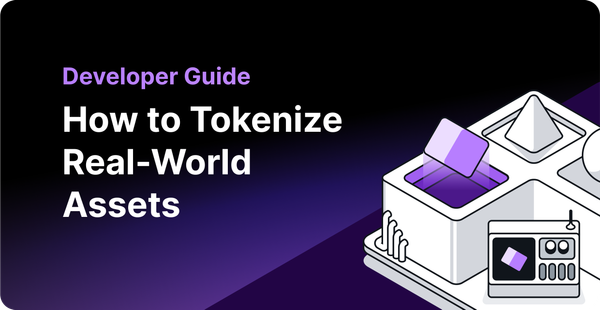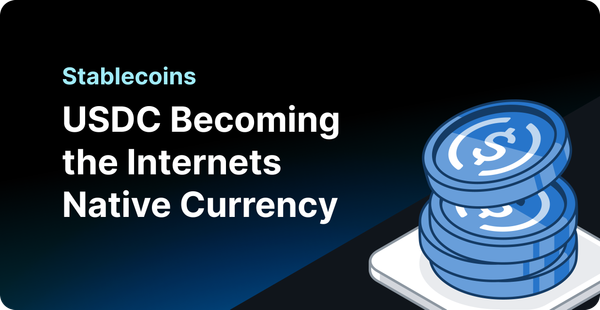[Webinar] NFT Adoption in the Bear Market: Insights from QuickNode, Solanart, and Coindesk
Join leading experts from Quicknode and Solanart as they discuss the growth of NFT adoption and predict the top use cases set to become mainstream.
![[Webinar] NFT Adoption in the Bear Market: Insights from QuickNode, Solanart, and Coindesk](/content/images/size/w1200/2023/02/nft-adoption-in-the-bear-market-insights-from-quicknode-solanart.png)
In this CoinDesk discussion, Auston Bunsen, Co-founder of Quicknode, Hari Masoor, Senior Blockchain Solution Architect at Quicknode, and Quentin Crépy, Co-founder and CEO of Solanart, discuss how NFT adoption has continued to grow despite the down-market, including by Fortune 500 companies. They discuss their predictions for top NFT use cases that will become mainstream in the near future. This webinar also outlines how interested users can quickly and easily get involved in NFTs and blockchain/Web3 development.
Overview of Topics
- Where NFTs Have Shined Despite the Bear Market
- NFT Adoption by Fortune 500 Companies
- Predictions for Top Use Cases in the Near Future
- How You Can Get Involved
- State of Privacy on Web3
- Why QuickNode Acquired icy.tools and Launched it as an API
(4:45) Where NFTs Have Shined Despite the Bear Market
Following introductions, Auston Bunsen, Co-founder of QuickNode, begins the webinar discussion by looking retrospectively at how NFTs performed in 2021 and 2022 despite the market downturn of cryptocurrencies and blockchain technologies.
NFT Industry Statistics at a Glance
- $2.98 billion Total Fundraising Amount in 2022
- $55.5 billion Total NFT Sales (up 175% from 2021)
- 85,000 Collections Launched in 2022
- 95% NFT Volume Took Place on the Ethereum Chain
- 32,400 Unique Wallets Hold 2.7 million NFTs
- 2.14 million Total Traders in 2022
(5:40) Use Cases
Auston goes on to give an overview of his team's predictions for 2023 and has divided his predictions for NFT use cases into "three major buckets" to organize NFTs depending on their intended function.
(6:04) Loyalty Programs
- Starbucks Odyssey Loyalty Program is the first example Auston uses, which has been covered by Coindesk and launched in beta on December 8, 2022, to select U.S. reward members. The Starbucks app already has 40 million regular users, with over half of those users ordering directly from the app daily.
- The idea behind the Odyssey Loyalty Program is to introduce current loyalty program members to NFTs and provide a more immersive customer experience. Users will collect NFTs and engage in interactive "Journeys" to earn "Journey Stamps" in the form of NFTs built on Polygon. Starbucks Odyssey will also include "Odyssey Points" that will provide access to new benefits and experiences in the near future, such as virtual espresso martini-making classes and events.
(6:52) The following example Auston uses is Nike's 2021 acquisition of RTFKT, a brand that uses NFTs to merge culture and gaming. The team uses the latest in NFTs, game engines, blockchain authentication, and augmented reality to build and distribute virtual products and experiences to users.
Before moving on, Auston's third example is Budweiser, which collaborates with Zed Run to build and launch NFT games in a marketing and sponsorship deal.
(9:55) Authentication
- StockX has an authentication platform service that pre-verifies a product such as shoes, a watch, or another consumer good and then issues an NFT that is fully tradeable on its website. With StockX, users can verify the item they're buying is authentic before buying, as it's verified via the platform, and they don't have to worry about buying knock-off Airforce 1's or other items.
- Another example is UniSocks from the Uniswap team, where users can buy and sell real socks with digital currency via the NFT of the product.
- BlockPharma is the next example used, which provides drug traceability and anti-counterfeiting solutions.
- The last example is BlockBar, which produces NFTs for companies like Glenfiddich, tracking ownership back to the distillery itself and allowing users to trade that NFT for an actual, physical bottle.
(13:18) Ownership
- Auston's last point regarding the bright spots where NFTs have shined over the last couple of years is ownership, which was the original use case for NFTs, and intended to provide censorship-resistant ownership of any asset in the world.
- The first example company is Breitling, which has been issuing NFTs since 2020 with every Breitling watch purchase. If you resell the watch, you can transfer the NFT to the new watch owner, who can verify the authenticity of previous owners via their NFT. So, suppose someone were to buy a Breitling watch that the seller claimed used to belong to Jay-Z. In that case, they'll be able to verify that it did belong to Jay-Z because they can check the previous owners' wallet addresses on OpenSea, or another NFT trading platform.
- Unstoppable Domains is the next example Auston uses, which provides human-readable-friendly addresses and allows users to build a Web3 website with a domain they fully own and control. The domain is yours for life, with no renewal, gas, or hosting fees.
- The final example of ownership is Fractal Properties, a real estate NFT platform. Buying the NFT gives you ownership of the actual physical property. All the people and things you need to pay for to get the property, including title and insurance, can all be included in the NFT ownership. This allows you to keep more of your time and money by simplifying the transaction.
(17:18) Quentin of Solanart on the NFT Ecosystem Today
Solanart was the first marketplace created on Solana in 2021, and it's a free marketplace that doesn't take fees, a tactic to attract more users. Quentin says it's still too early to tell what will happen with NFTs in 2023, whether they will have four-year cycles like cryptocurrencies do or more like six months. He believes now, at the start of 2023, NFT adoption on Solanart is beginning a new wave in the wake of the FTX collapse, and new NFT collections are being released. Many collections are coming with real utility, not just selling arbitrary pixels.
(19:52) Hari of QuickNode on the NFT Ecosystem Today
QuickNode is the leader of NFT analytics on Ethereum, and its goal is to expand on that and become the leader of NFT development. Hari believes the use cases discussed will come to light and expand rapidly as brands and users see successes in the forerunning companies.
Hari sees the ecosystem and NFT adoption expansion and use cases becoming less speculative and moving toward actual use cases in real-world scenarios, transforming current processes.
(21:20) Auston's Prediction for Biggest Commercial Opportunity
Auston of QuickNode says ownership is the most significant use case and commercial opportunity for NFTs. Users will be able to own things on the internet and receive royalties for those owned items. He uses examples of creative assets, like movies, eBooks, and music, and physical assets, like gold, oil, and real estate. With NFTs, people can get away from all the intermediaries that come with owning things; people and entities requiring payment for you to own items.
Auston says that in addition to ownership, proving the provenance of physical and digital assets will be one of the most prominent use cases we see in the coming months and years as NFT adoption continues to build.
(25:57) Hari's Thoughts on Potential Applications and Benefits of NFTs and What the NFT Space Needs to Do to Bring More Web2 Companies Onboard
Hari believes the NFT space is almost at the tipping point now, with multinational companies like Starbucks and Nike pioneering the use of NFTs to bring their customers into Web3 with applications like the Starbucks Odyssey program and Nike's .SWOOSH.
Odyssey allows people to watch videos, such as how coffee beans are made and transported to Starbucks, play games, or get points for going to a Starbucks location you've not been to before and ordering a different drink than you've tried in the past and accruing points for that. In April 2023, Odyssey users can cash out their points.
Once it's a proven success and the users have had a good experience, that NFT use case model has worked. Hari believes once this happens, other franchises, especially food franchises, will try to get in on the action, too.
Nike is bringing the ability to create, collect, and trade virtual creations to its fanbase with the .SWOOSH NFT platform. Hari believes it'll be even bigger than use cases like Starbucks Odyssey. Hari uses an example that if some random 16-year-old comes out with a great design for the next Jordans on .SWOOSH, and that's proven by public vote and put into production, companies like Adidas and Puma will have to follow.
Smaller businesses, like a mom and pop coffee shop, can also create applications like NFT loyalty programs for their customers, which will be a dynamic opportunity to participate in growing NFT adoption.
(28:57) Quentin on the Biggest Issue Influencing NFT Adoption and Market Growth
Liquidity is the biggest hurdle on Solanart, Quentin says. Without liquidity, it will be challenging to push NFT adoption further, and it's the first issue he believes needs to be solved before anything else. Many people complain about not being able to sell an NFT or accepting a lower price to sell NFTs quickly.
(32:00) Auston on Solana Volatility
QuickNode has a macro vantage point, providing infrastructure to tens of thousands of customers. Of course, part of the volatility was due to the association with Sam Bankman-Fried and FTX. That association, coupled with an economic macro, people are thinking about which assets they can sell to fund their shortfall.
Another benefit of QuickNode's macro viewpoint is they're still seeing billions of API requests to the Solana blockchain on the QuickNode platform daily, so they don't see Solana going anywhere. Auston expects Solana to grow as projects like Teleport, Solanart, and Saga Phone are built and funded.
Quentin adds that he expects to see Solana grow and have a bright future because there's no other blockchain with such a small fee and a short time to process transactions.
(38:17) How Developers and Creators Can Get Involved With QuickNode and Utilize the Tools
QuickNode's goal is to make NFT creation as simple as possible, whether you're a developer or not, to make the barrier to entry as low as possible. Hari says you can set up your own NFT in under five minutes in three easy steps.
- Spin up the QuickNode service, allowing you to read and write information to the blockchain.
- Add the NFT add-on through the QuickNode marketplace, which partners with companies to enhance user functionality.
- Choose an NFT name and find your NFT image, and QuickNode will provide the five lines of code you need to deploy your NFT.
Hari says NFT development can become more complicated, depending on what you want to do with your NFT, but the goal is to make the creation process as easy as possible by partnering with more and more companies to provide functionalities that simplify the process for the end user.
(42:29) State of Privacy on Web3
Quentin begins by saying that people often think they're anonymous because they changed wallets, but they're not anonymous because they usually fund that wallet with another wallet. A blockchain analyst he spoke with said that around 65% of active Bitcoin wallet addresses can be traced to an actual user, and that user isn't anonymous. Quentin thinks people need to be better educated about how blockchains work, so they understand their privacy when using blockchain technology.
(45:30) Hari believes that as time goes on, larger governments will try to understand which wallet addresses are tied to individuals. That is an initiative some of the tax companies that QuickNode works with are also pursuing.
From a security standpoint, the security hygiene that people practice on Web2 will also have to translate over to Web3.
Auston explains that one of the core traits of blockchain is traceability and an immutable fact of blockchain technology. However, the more activity there is on a chain, the harder it is for governments to trace who sent what asset, and at scale, it becomes impractical to do, empowering more user privacy.
(50:18) What is icy.tools?
icy.tools is the leading analytics provider for NFT tools on Ethereum. It's an excellent tool for investor enthusiasts because it provides key metrics on sales, sales floor, volume, and market cap data. These key metrics allow investors to make knowledgeable decisions before selling, buying, or trading an NFT.
For advanced users, icy.tools is also valuable because all of this metric data is provided via API. So, if you already have a custom trading rig, you'll be able to enable the icy.tools API and augment what you're already doing.
QuickNode acquired icy.tools because they realized the opportunity to package icy.tools as an API that can be used as a fundamental building block. As QuickNode is an infrastructure company, they saw icy.tools as a must-have API for the QuickNode platform.
Demystifying NFTs: Key Takeaways
It's clear from the webinar that all the participants believe NFTs have countless real-world use cases — and that global adoption is just getting started. Here are the key takeaways from our Web3 industry experts:
- NFTs performed well in 2021 and 2022 despite the market downturn of cryptocurrencies and blockchain technologies
- Auston, Co-founder of QuickNode, believes NFT use cases are divided into three major buckets: Loyalty Programs, Authentication, and Ownership
- Example of Loyalty Program: Starbucks Odyssey Loyalty Program, where members collect NFTs and engage in interactive "Journeys" to earn "Journey Stamps"
- Example of Authentication: StockX, a platform that pre-verifies products and issues an NFT that is fully tradeable
- Example of Ownership: Breitling, which issues NFTs with every watch purchase, allowing for verification of previous owners
- Quentin of Solanart believes NFT adoption is beginning a new wave at the start of 2023, with many collections coming with real utility
- Hari of QuickNode's goal is to expand on its leadership in NFT analytics on Ethereum.
- QuickNode has a macro viewpoint, providing infrastructure to thousands of customers and seeing billions of API requests to the Solana blockchain daily.
- Solana is expected to grow as projects like Teleport, Solanart, and Saga Phone are built and funded.
- QuickNode's goal is to make NFT creation as simple as possible, with a low barrier to entry, by partnering with more companies to provide functionalities that simplify the process for the end user.
- Quentin thinks people need to be better educated about blockchain privacy as they are not anonymous even if they change wallets.
- Hari believes that larger governments will try to understand which wallet addresses are tied to individuals in the future.
- The more activity on a chain, the harder it is for governments to trace transactions, empowering more user privacy.

About QuickNode
QuickNode is building infrastructure to support the future of Web3. Since 2017, we've worked with hundreds of developers and companies, helping scale dApps and providing high-performance access to 16+ blockchains. Subscribe to our newsletter for more content like this and stay in the loop with what's happening in Web3!





